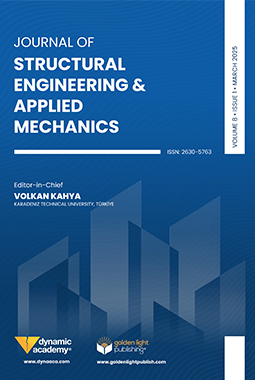ISSN:2630-5763
Journal of Structural Engineering & Applied Mechanics
ARTICLES
Sadık Can Girgin
Cem Göksoy
Emine Daş
İbrahim Serkan Mısır
In precast reinforced concrete buildings, which constitute an important part of the industrial buildings in Turkey, the force flow between the structural elements is provided by beam-column connections with or without transferring moments. In general, moment resisting beam-column connections with mechanical or emulative components are applied at the mezzanine level. For precast concrete structures, strength-based design is the most common design approach in engineering practice. In recent years, performance based seismic design and evaluation approach also gained attention which provides numerical estimation of the damage in structural elements subjected to earthquake loading. This study presents the performance based seismic assessment of a two-story precast building based on the seismic evaluation requirements of Turkish Building Earthquake Code 2018. For this purpose, numerical simulation model has been established by using lumped plasticity models for connections and distributed plasticity models for columns. Strong ground motion records are scaled based on TBEC-2018 acceleration spectrum for a specific location, and nonlinear time history analyses are performed in x and y directions simultaneously. The performance evaluation results using average deformations show that there is a significant difference between plastic rotation and reinforcing bar strain performance limits.
https://doi.org/10.31462/jseam.2021.03140150
Muhamad Zulfakar
Ali İhsan Karakaş
In this study the time history analyses are carried out three dimensionally for a simple five-story concrete structure seismically isolated incorporating triple friction pendulum bearings with different sliding surface properties with the help of the ABAQUS finite element program. The altering friction surface properties are friction coefficient and radius of curvature. The performances of the various isolators are compared with each other as well as with those of a fixed based structure. For this purpose, maximum relative story displacements, story accelerations and column base shear forces are investigated as seismic reactions. According to the analysis results it can be stated that the seismic reactions of isolated structures are significantly reduced when compared to those of the fixed supported structure. Additionally, when triple friction pendulum bearing isolators with different friction coefficients and friction surface radii are compared, it can be observed that increasing the friction coefficient increases the reactions of the structure while increasing the friction surface radii decreases the reactions.
https://doi.org/10.31462/jseam.2021.03151162
Ahmet Can Altunışık
Volkan Kahya
Ali Yetişken
This work aims to experimentally show the effectiveness of annular cylindrical tuned liquid dampers (ACTLDs) on the classical tuned liquid column dampers (TLCDs) under the effect of inclined ground motion. For experimental measurements, a single-story model structure constituted by two plates at the top and bottom connected by four columns was constructed. Since the water length within the tuned liquid dampers (TLDs) is a very important parameter that affects the performance of the absorber, ACTLD and TLCD devices were designed such that their total water lengths be equal for comparison purposes. The modal characteristics of the model structure were determined by ambient vibration tests. The resonant frequency, head-loss coefficient, damping ratio, and water height-frequency diagram of ACTLD and TLCD devices were obtained experimentally through the shaking table tests. Then, the shaking table tests on the model structure with and without the absorbers under consideration were performed to obtain the acceleration and displacement time-histories and the damping ratio for the coupled system. In experimental tests, different excitation directions from 0o to 90 o were considered. Results of the study show that ACTLDs are better than TLCDs at suppressing vibrations caused by ground motions acting on the structure at oblique angles.
https://doi.org/10.31462/jseam.2021.03163183
Erdi Gülbahçe
Mehmet Çelik
This paper presents a fuzzy-logic-based observer and a positive position feedback controller to reduce a standard beam's free vibrations using a piezoelectric actuator. It is aimed that fuzzy-logic-based observer is used as feed-through and improves the overall performance of the PPF controller. For this aim, the cantilever beam and a piezoelectric patch are initially numerically modeled using the finite element method considering the close loop control algorithm. The displacement and strain responses results are compared with the experimental model. Then, two controllers are applied to the designed system: positive position feedback (PPF) and fuzzy-logic-based positive position feedback (FLBPPF). The uncontrolled and controlled system responses are investigated and compared in terms of the linear strain and tip displacement results. Using the FLBPPF controller, the settling times of controlled systems are decreased by about 20.7% and 41.6% regarding the linear strain and tip displacement response compared to the PPF controller.
https://doi.org/10.31462/jseam.2021.03184195
Taha Yasin Altıok
Ali Demir
Historical structures should be carefully preserved and transferred to the next generations. Therefore, their seismic performances should be investigated in detail. In the finite element method, many parameters affect the seismic behaviour and damage distribution in the structures. One of the most significant parameters is the Soil-Structure Interaction effect. In finite element analyses, the soil medium is generally neglected, and the structures' base is restrained by fixed supports. In this study, seismic response of a historical masonry minaret is investigated by considering the Soil-Structure Interaction and Operational Modal Analysis methods. To determine the effect of Soil-Structure Interaction on structural behaviour, the fixed supports, hard and soft soil mediums at the base of the structure are modelled. The material and failure behaviours are defined with the Concrete Damage Plasticity model. Displacements, principal stresses, damage rates, and damage distribution of models are obtained with nonlinear time history analyses. According to the results, the interstory drift increases due to the decrease in the stiffness of the soil media. In addition, the fixed supports model was damaged more tensile stress damage than the other models. The least occurred in the soft soil model. It is concluded that the Soil-Structure Interaction effect significantly affects structural behaviour, especially the damage rate and distribution.
https://doi.org/10.31462/jseam.2021.03196212


